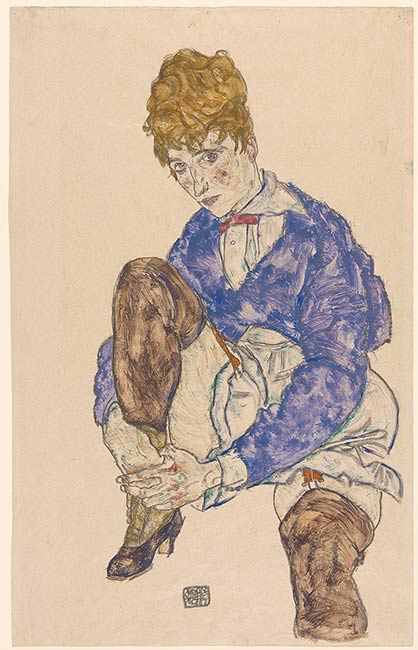
On 17 June 1915, Schiele married Edith Harms, a well educated, middle-class woman, three years his junior. From then on, until they both died in an epidemic of Spanish flu in October 1918, she was his principal model. Schiele made two full-length oil portraits of her, in 1915 and in 1918, and dozens of drawings and watercolors. Edith also posed for the numerous drawings of nudes he continued to produce during these years. The drawing illustrated here - one of nine sheets by Schiele in the collection of the Morgan Library - is related to the second oil portrait (Oesterreichische Galerie, Belvedere, Vienna RF: 1991). Whereas the painting shows Edith conventionally seated on a chair, wearing a long skirt that covers her legs, the drawing combines a formal treatment in the upper part of the figure with reminiscences of Schiele's more erotic works in the position of the legs, the exposed flesh of the thighs, and the detail of the red garters.
The realism of the drawing reflects the classicizing direction that Schiele's art was taking in the last years of his career. Although Edith's pose is sexually suggestive, it is far from the highly provocative, contorted poses of the works that made the artist such a controversial figure in Vienna during the early teens. The hands, which used to play a major part in the expressive power of Schiele's drawings with their convulsive, overtly symbolic gestures, are here linked together and, with the arms, form an oval motif that evokes a more introspective mood and peaceful state of mind. This feature, repeated in the oil portrait in which Edith's hands hold, not her leg, but the armrest of the chair, is notable in many of Schiele's late portraits.
Stylistically the drawing also illustrates Schiele's evolution toward less dramatic effects. The angular, jagged lines of his early works have given way to more fluid, sensitive contours, as well as a greater interest in suggesting volume and modeling. Visible brushstrokes animate the surface, especially in the stockings and sweater, where the paint, applied with a dried brush, presents frequent variations in density. The subdued palate for brown, ochre, and blue, which has replaced the lurid reds and yellows Schiele previously favored, also contributes to the softer mood. With these changes, Schiele has moved away from the influence of Gustave Klimt (1862-1918), which was predominant at the beginning of his career, and closer to the art of Oskar Kokoschka (1886-1980).
In 1917, when he painted this portrait, Schiele was beginning to achieve wider recognition in the Viennese art world. His work was frequently exhibited, and he received several portrait commissions. If his radical works of 1910-12, tense and feverish, projected the young man's tortured psychology, his late portraits, such as this one, were the work of a more mature artist and expressed instead feelings of sympathy, even tenderness, toward the sitter.
Watermark: none.
